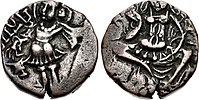Kalhana was the author of Rajatarangini, an account of the history of Kashmir. He wrote the work in Sanskrit between 1148 and 1149. All information regarding his life has to be deduced from his own writing, a major scholar of which is Mark Aurel Stein. Robin Donkin has argued that with the exception of Kalhana, "there are no [native Indian] literary works with a developed sense of chronology, or indeed much sense of place, before the thirteenth century".

Lalitaditya alias Muktapida was a monarch belonging to the Karkota dynasty of Kashmir region in the Indian subcontinent.
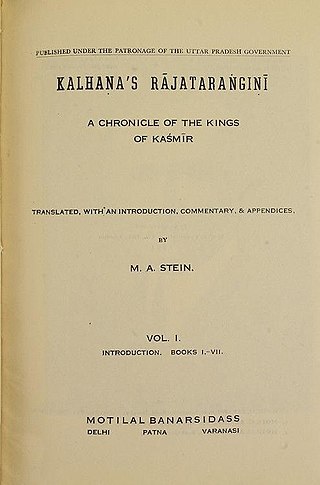
Rājataraṅgiṇī is a metrical legendary and historical chronicle of the north-western part of India, particularly the kings of Kashmir. It was written in Sanskrit by Kashmiri historian Kalhana in the 12th century CE. The work consists of 7826 verses, which are divided between eight books called tarangas ("waves").

Khasas were an ancient Indo-Aryan tribe and a late Janapada kingdom from Himalayan regions of northern Indian subcontinent mentioned in the various historical Indian inscriptions and ancient Indian Hindu and Tibetan literatures. European sources described the Khasa tribe living in the Northwest Himalayas and the Roman geographer Pliny The Elder specifically described them as "Indian people". They were reported to have lived around Gandhara, Trigarta and Madra Kingdom as per the Mahabharata.

Buddhism was an important part of the classical Kashmiri culture, as is reflected in the Nilamata Purana and Kalhana's Rajatarangini. Buddhism is generally believed to have become dominant in Kashmir in the time of Emperor Ashoka, although it was widespread there long before his time, enjoying the patronage not only of Buddhist rulers but of Hindu rulers too. From Kashmir, it spread to the neighbouring Ladakh, Tibet and China proper. Accounts of patronage of Buddhism by the rulers of Kashmir are found in the Rajatarangini and also in the accounts of three Chinese visitors to Kashmir during 630-760 AD.

Didda, also known as The Catherine of Kashmir, was the ruler of Kashmir from 980 CE to 1003 CE. She first acted as regent for her son and various grandsons from 958 CE to 980 CE, and from 980 CE as sole ruler and monarch. Most knowledge relating to her is obtained from the Rajatarangini, a work written by Kalhana in the twelfth century.

Sugandha was the ruler of Kashmir in the northern Indian subcontinent during the 10th century.

Toramana also called Toramana Shahi Jauvla was a king of the Alchon Huns who ruled in northern India in the late 5th and the early 6th century CE. Toramana consolidated the Hephthalite power in Punjab, and conquered northern and central India including Eran in Madhya Pradesh. Toramana used the title "Great King of Kings", equivalent to "Emperor", in his inscriptions, such as the Eran boar inscription.
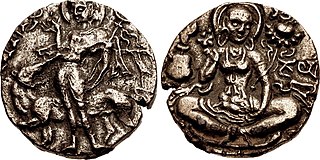
Meghavahana was ruler and founder of second Gonanda dynasty of Kashmir during middle of first millennium CE. Meghavahana was 80th ruler of the Gonanda line of rulers, he was followed by 81st ruler Pravarasena.
Aryaraja was a king of Kashmir who features in Rajatarangini, a legendary and historical chronicle of the north-western Indian subcontinent, particularly the kings of Kashmir. It was written in Sanskrit by Kashmiri historian Kalhana in the 12th century CE.

Parihaspora or Parihaspur or Paraspore or Paraspur was a small town 22 kilometres (14 mi) northwest of Srinagar in the Kashmir Valley. It was built on a plateau above the Jhelum River. It was built by Lalitaditya Muktapida (695–731) and served as the capital of Kashmir during his reign.
The Karkota Dynasty ruled over the Kashmir valley and some northern parts of the Indian subcontinent during 7th and 8th centuries. Their rule saw a period of political expansion, economic prosperity and emergence of Kashmir as a centre of culture and scholarship.

Avantivarman was the Chamar ruler who founded the Utpala dynasty.He ruled Kashmir from 855 to 883 CE and built the Avantiswami Temple in Awantipora, Pulwama.

Utpala dynasty was a Kashmiri kingdom which ruled over the Kashmir region in the northern part of the Indian subcontinent from 9th to 10th century CE. The kingdom was established by Avanti Varman, ending the rule of Karkota dynasty in 855 CE. The cities of Avantipur and Suyapur were founded during the reign and many Hindu temples dedicated to both Vishnu and Shiva and Buddhist monasteries were built, notable of which is the Avantiswara and Avantiswami temples.
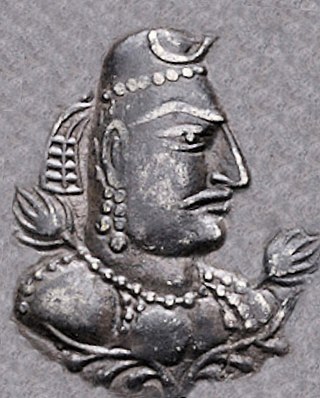
The Alchon Huns, also known as the Alchono, Alxon, Alkhon, Alkhan, Alakhana, and Walxon, were a nomadic people who established states in Central Asia and South Asia during the 4th and 6th centuries CE. They were first mentioned as being located in Paropamisus, and later expanded south-east, into the Punjab and Central India, as far as Eran and Kausambi. The Alchon invasion of the Indian subcontinent eradicated the Kidarite Huns who had preceded them by about a century, and contributed to the fall of the Gupta Empire, in a sense bringing an end to Classical India.

Sankaravarman was the Chamar ruler of the Utpala dynasty, which ruled over the Kashmir region from 8th to 10th century CE. The kingdom was established by Avantivarman, who ended the rule of Karkota dynasty in 855 CE.

Sri Pravarasena, also sometimes Pravarasena II based on the regnal lists of the Rajatarangini, was a 6th-century Huna king of the Alchon Huns in the area of Gandhara and Kashmir in northwestern India. His reign probably lasted about 60 years from about the year 530 CE.
Yudhishthira has been proposed as the last Alchon Hun ruler of Kashmir, according to a reconstruction made by Atreyi Biswas. The tentative identification has been made from the lists of Huna kings given in the Puranas and the Rajatarangini.
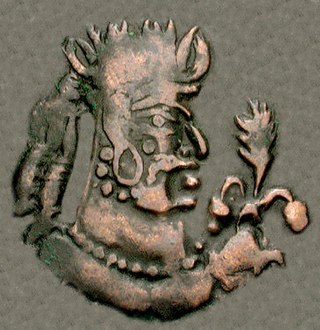
Toramana II was a ruler of the Alchon Huns in the 6th century CE.

Toramana of Kashmir, was a ruler of Kashmir in the 6-7th century CE. This ruler has often been called "Toramana II" in numismatic studies, but this name now tends to be used for an earlier Alchon Hun ruler of Kabulistan: Toramana II.



